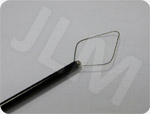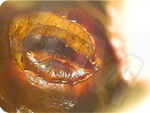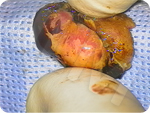Conization involves the surgical removal of a piece of cervical tissue (of varying volume) as shown in the image. The goal of this procedure is twofold:
- therapeutic to remove the lesion
- diagnostic to remove a lesion in order to analyze:
- that the lesion is successfully removed when the edges of the lesion area are clear
- the characteristics of the lesion removed correspond to those of the preoperative biopsies (conducted with colposcope) in order to eliminate any risk of nascent cervical cancer which may been underestimated at the biopsy stage
It is therefore imperative that the laboratory conducting the analysis receives a good quality piece of cervical tissue and that it is examined by a top quality pathologist in this field.
Conization in practice.
Several conization methods exist:
- Traditional conization performed with a surgical scalpel which is rarely practiced nowadays.
- Laser conization, a common procedure in the 1990s is now seldom performed because it is quite a lengthy procedure.
- A Loop Electrical Excision Procedure (LEEP), which today is the most widely practiced procedure.
- Straight wire excision of transformation zone (SWETZ) electrosurgical conization.
Conization procedures that remove segments of varying size may impact cervical competence. It is therefore imperative to minimize the extent of the resection in order to maximise the healing process. Thus it is essential that the procedure be carried out by a top quality surgeon in the field (one who is a member of the charter for colposcopy quality: the charter guarantees initial and continuous training in cervical pathologies).
How to choose between the different conziation methods?
Normally the experienced surgeon assesses which method is appropriate given the size of the lesion and its depth inside the cervix.
Broadly speaking, for lesions that are quite contained (85% of cases) one opts for the LEEP (Loop Electrical Excision Procedure), and for more serious lesions (10-15% of cases) one opts for the Straight wire excision of transformation zone (SWETZ).
Clearly the dichotomy as laid out here is very general and the appropriate method depends on the wealth of experience of the doctor.
Loop Electrical Excision Procedure (LEEP) or LLETZ (for large loop excision of Transformation zone) in practice:
- LEEP or LLETZ procedures are normally carried out inFrance in a healthcare facility operating theatre (clinic or hospital).
- This procedure is often carried out under local anesthetic, although in some cases requires a general anesthetic, when for example the lesions are broadly spread, located in sensitive areas, or in areas that are multifocal or difficult to access.
- The doctor places a speculum into the vagina and then performs a colposcopy (using colourants) to clearly locate the extent of the lesions.
- The area to be treated is numbed before a local anesthetic is administered in the cervix via para or intracervical injections.
- The electric cutter (loop) is put in place and charged to the required strength and the smoke suction device (it is sometimes quite noisy) is switched on in order to maintain perfectly clear visual access.
- Once the resection starts, the procedure for the removal of cervical lesions takes approximately 10 minutes.
- The speculum is then withdrawn and the patient is free to go home and return to normal activity. When the procedure is conducted with only local anesthetic, it is often unnecessary to take time off work.
- Pain should not be experienced after the procedure but the patient may experience yellowish or pinkish vaginal discharge which indicates healing.
- In rare cases (1-2%) significant bleeding may occur 8-10 days after the procedure. This may be due to some scar tissue that formed after the operation falling away and reopening the blood vessels. It is thus important to remain close to the center that conducted the operation and not to travel for 2 weeks following the procedure.
- Pads should be used instead of tampons for 3 weeks
- Sexual intercourse should also be avoided for 3 weeks.
- Douching should not be done and swimming pools avoided for 3 weeks.
- Furthermore, in rare cases, (of the order of 3-4%) significant bleeding with clots may occur 8-14 days after the procedure. It is thus advisable not to travel during this period.
- If pain is experienced in the pelvic area, or heavy bleeding occurs, the patient should immediately call the doctor who performed the procedure. It is strongly recommended that a follow up check be made 3 months after the procedure so the doctor can verify that the lesions are still absent and that the healing process is properly underway.
- In general this procedure does not appear to impact fertility. However, if the volume of tissue removed is significant (greater than a 10mm endocervical resection), there may be a higher risk of premature delivery.
- Conization is not 100% effective.It is therefore necessary to schedule regular monitoringin order to verify there has been zero recurrence or any persistent HPV lesions.

An electric wire loop

Resection of a cervical lesion

Example of a part of a resection by hot wire loop
What is electric conization (SWETZ, straight wire excision of transformation zone) in practice?
- In general SWETZ procedures are normally carried out ina healthcare facility operating theatre (clinic or hospital).
- These procedures are normally carried out under general anesthetic given the more significant extent or depth of the lesions being removed. This treatment is rarely given under local anesthetic.
- The doctor places a speculum into the vagina and then performs a colposcopy (using colorants) to clearly locate the extent of the lesions.
- The electric cutter is put in place and charged to the required strength and the smoke suction device (which can often be noisy) is switched on in order to maintain perfectly clear visual access.
Once the resection starts, the procedure for the removal of cervical lesions takes approximately 10-20 minutes. - Given that the volume of tissue being removed is significant it can sometimes be necessary to suture the area (the sutures are subsequently reabsorbed)
- The speculum is then withdrawn and the patient is free to go home after several hours of postoperative monitoring.
- Pain should not be experienced after the procedure but the patient may experience yellowish or pinkish vaginal discharge which indicates that healing is taking place.
- In rare cases (1-2%) significant bleeding may occur 8-10 days after the procedure. This may be due to some scar tissue that formed after the operation falling away and reopening the blood vessels. It is thus important to remain close to the center that conducted the operation and not travel for 2 weeks following the procedure.
- Pads should be used instead of tampons for 3 weeks.
- Sexual intercourse should also be avoided for 3 weeks.
- Douching should not be done and swimming pools avoided for 3 weeks.
- Furthermore, in rare cases, (of the order of 3-4%) significant bleeding with clots may occur 8-14 days after the procedure. It is thus advisable not to travel during this period.
- If pain is experienced in the pelvic area, or heavy bleeding occurs, the patient should immediately call the doctor who performed the procedure. It is strongly recommended that a follow up check be made 3 months after the procedure so the doctor can verify that the lesions are still absent and that the healing process is underway.
- In general this procedure does not appear to impact fertility. However, if the volume of tissue removed is significant (greater than a 10mm endocervical resection), there may be a higher risk of premature delivery. Therein lays the importance of appropriate diagnosis.
Electric conization treatment is not 100% effective. It is therefore necessary to schedule regular monitoring in order to verify there has been zero recurrence or any persistant HPV lesions.


